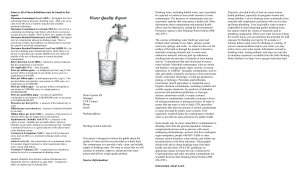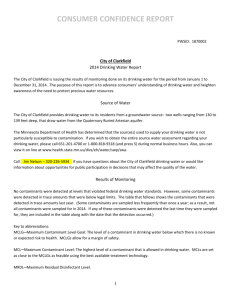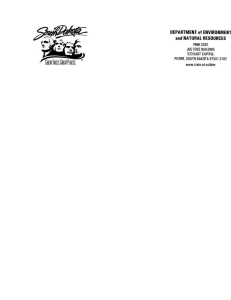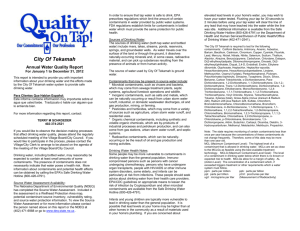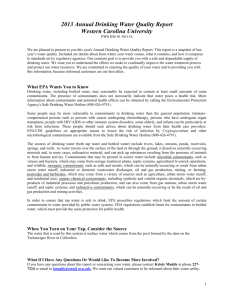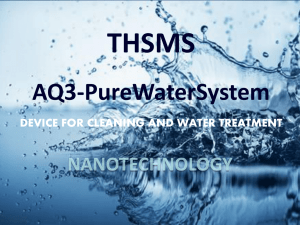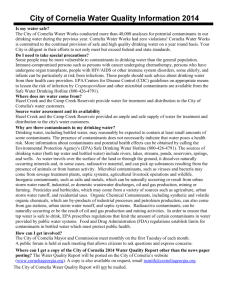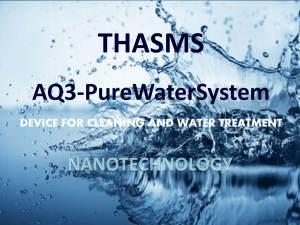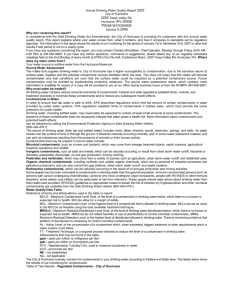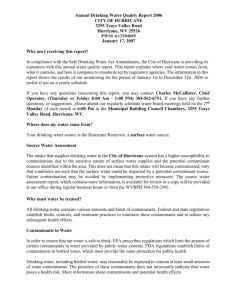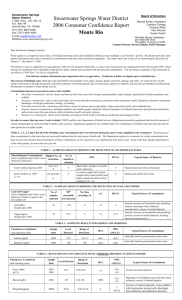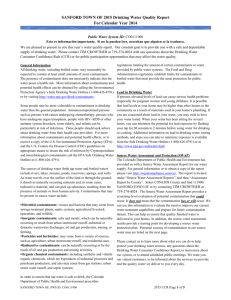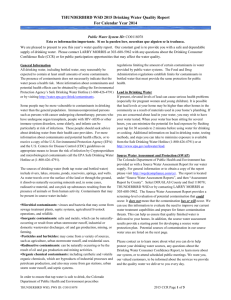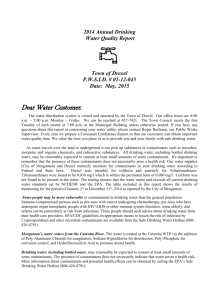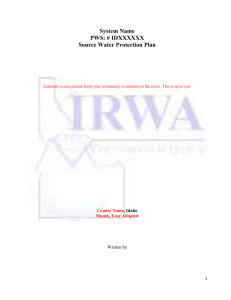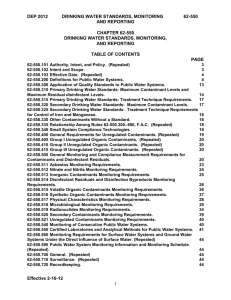Compound & Unit Highest Level Allowed by Regulation (MCL
advertisement
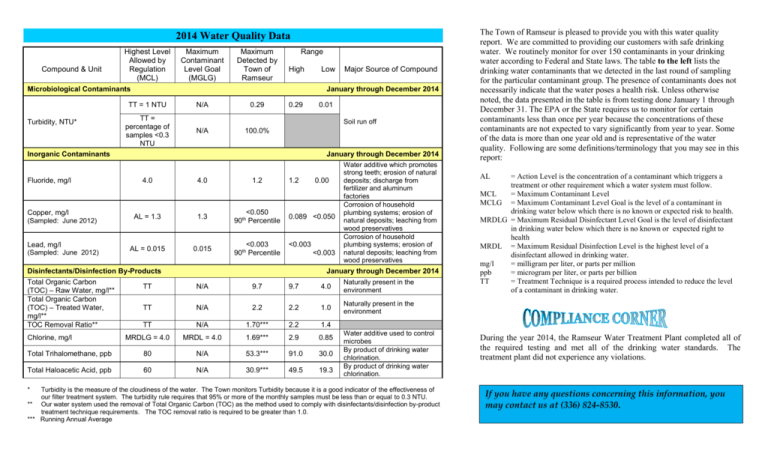
2014 Water Quality Data Highest Level Allowed by Compound & Unit Regulation (MCL) Microbiological Contaminants Turbidity, NTU* Maximum Contaminant Level Goal (MGLG) Maximum Detected by Town of Ramseur Range High Copper, mg/l (Sampled: June 2012) Lead, mg/l (Sampled: June 2012) TT = 1 NTU N/A 0.29 TT = percentage of samples <0.3 NTU N/A 100.0% 0.29 0.01 Soil run off January through December 2014 4.0 4.0 1.2 AL = 1.3 1.3 <0.050 90th Percentile AL = 0.015 0.015 <0.003 90th Percentile 1.2 0.00 0.089 <0.050 <0.003 <0.003 Disinfectants/Disinfection By-Products Total Organic Carbon (TOC) – Raw Water, mg/l** Total Organic Carbon (TOC) – Treated Water, mg/l** TOC Removal Ratio** Major Source of Compound January through December 2014 Inorganic Contaminants Fluoride, mg/l Low Water additive which promotes strong teeth; erosion of natural deposits; discharge from fertilizer and aluminum factories Corrosion of household plumbing systems; erosion of natural deposits; leaching from wood preservatives Corrosion of household plumbing systems; erosion of natural deposits; leaching from wood preservatives January through December 2014 TT N/A 9.7 9.7 4.0 Naturally present in the environment TT N/A 2.2 2.2 1.0 Naturally present in the environment TT N/A 1.70*** 2.2 1.4 MRDLG = 4.0 MRDL = 4.0 1.69*** 2.9 0.85 Total Trihalomethane, ppb 80 N/A 53.3*** 91.0 30.0 Total Haloacetic Acid, ppb 60 N/A 30.9*** 49.5 19.3 Chlorine, mg/l * Water additive used to control microbes By product of drinking water chlorination. By product of drinking water chlorination. Turbidity is the measure of the cloudiness of the water. The Town monitors Turbidity because it is a good indicator of the effectiveness of our filter treatment system. The turbidity rule requires that 95% or more of the monthly samples must be less than or equal to 0.3 NTU. ** Our water system used the removal of Total Organic Carbon (TOC) as the method used to comply with disinfectants/disinfection by-product treatment technique requirements. The TOC removal ratio is required to be greater than 1.0. *** Running Annual Average The Town of Ramseur is pleased to provide you with this water quality report. We are committed to providing our customers with safe drinking water. We routinely monitor for over 150 contaminants in your drinking water according to Federal and State laws. The table to the left lists the drinking water contaminants that we detected in the last round of sampling for the particular contaminant group. The presence of contaminants does not necessarily indicate that the water poses a health risk. Unless otherwise noted, the data presented in the table is from testing done January 1 through December 31. The EPA or the State requires us to monitor for certain contaminants less than once per year because the concentrations of these contaminants are not expected to vary significantly from year to year. Some of the data is more than one year old and is representative of the water quality. Following are some definitions/terminology that you may see in this report: AL = Action Level is the concentration of a contaminant which triggers a treatment or other requirement which a water system must follow. MCL = Maximum Contaminant Level MCLG = Maximum Contaminant Level Goal is the level of a contaminant in drinking water below which there is no known or expected risk to health. MRDLG = Maximum Residual Disinfectant Level Goal is the level of disinfectant in drinking water below which there is no known or expected right to health MRDL = Maximum Residual Disinfection Level is the highest level of a disinfectant allowed in drinking water. mg/l = milligram per liter, or parts per million ppb = microgram per liter, or parts per billion TT = Treatment Technique is a required process intended to reduce the level of a contaminant in drinking water. During the year 2014, the Ramseur Water Treatment Plant completed all of the required testing and met all of the drinking water standards. The treatment plant did not experience any violations. If you have any questions concerning this information, you may contact us at (336) 824-8530. Water is found in the form of rivers, lakes, streams, ponds, reservoirs, springs, and wells. As water travels over the ground or through the ground, it dissolves naturally occurring minerals and, in some cases, radioactive material. In addition, it also comes in contact with substances resulting from the presence of animals or human activity. Contaminants that may be present in source water include: (A) Microbial contaminants, such as viruses and bacteria, which may come from sewage treatment plants, septic systems, agricultural livestock operations, and wildlife (B) Inorganic contaminants, such as salts and metals, which can be naturally-occurring or result from urban stormwater runoff, industrial or domestic wastewater discharges, oil and gas production, mining, or farming (C) Pesticides and herbicides, which may come from a variety of sources such as agriculture, urban stormwater runoff, and residential uses (D) Organic chemical contaminants, including synthetic and volatile organic chemicals, which are by-products of industrial processes and petroleum production. Drinking water, including bottled water may be expected to contain at least small amounts of some contaminates. The presence of these contaminants does not indicate that the water poses a health risk. What matters is what kind of contaminants that are in the water and how much. The Environmental Protection Agency regulates the amounts of contaminants that are acceptable in public drinking water through the Safe Drinking Water Act of 1974 and its amendments. More information about drinking water constitutes and potential health effects can be obtained by calling the Environmental Protection Agency’s Safe Drinking Water Hotline (800426-4791). Source Water Assessment Lead In Drinking Water The source of our water supply is Kermit Pell Reservoir (Sandy Creek Reservoir). If present, elevated levels of lead can cause serious health problems, especially for pregnant women and young children. Lead in drinking water is primarily from materials and components associated with service lines and home plumbing. The Town of Ramseur is responsible for providing high quality drinking water, but cannot control the variety of materials used in plumbing components. When your water has been sitting for several hours, you can minimize the potential for lead exposure by flushing your tap for 30 seconds to 2 minutes before using water for drinking or cooking. If you are concerned about lead in your water, you may wish to have your water tested. Information on lead in drinking water, testing methods, and steps you can take to minimize exposure is available from the Safe Drinking Water Hotline or at http://www.epa.gov/safewater/lead. The Public Water Supply Section of the NC Department of Environment and Natural Resources conducted a source water assessment of Sandy Creek Reservoir. The source water assessment is a determination of the susceptibility of Sandy Creek Reservoir’s potential to become contaminated by potential contaminant sources. The susceptible rating is determined by combining the contaminant rating (number and location of PCSs within the assessment area) and the inherent vulnerability rating (i.e. characteristics or existing conditions of the watershed and its delineated assessment area). The susceptibility rating for Sandy Creek Reservoir is moderate. Please note that this rating does not imply poor water quality. This information was obtained from the SWAP report dated June 26, 2014. The complete SWAP Assessment report for the Ramseur Water Treatment Plant may be viewed on the Web at: www.ncwater.org/pws/swap. Note that because SWAP results and reports are periodically updated by the PWS Section, the results available on this web site may differ from the results that were available at the time this CCR was prepared. If you are unable to access your SWAP report on the web, you may mail a written request for a printed copy to: Source Water Assessment Program – Report Request, 1634 Mail Service Center, Raleigh, NC 27699-1634, or email requests to swap@ncdenr.gov. Please indicate your system the water system name and number, and provide your name, mailing address and phone number. If you have any questions about the SWAP report please contact the Source Water Assessment staff by phone at 919-707-9098. Special Warning Some people may be more vulnerable to contaminants in drinking water than the general population. Immunocompromised person such as persons with cancer undergoing chemotherapy, persons who have undergone organ transplants, people with HIV/AIDS or other immune systems disorders, some elderly, and infants can be particularly at risk from infections. These people should seek advice about drinking water from their health care providers. EPA/CDC guidelines on appropriate means to lessen the risk of infection by Cryptosporidium and other microbial contaminants are available from the Safe Drinking Water Hotline (800-426-4791).
